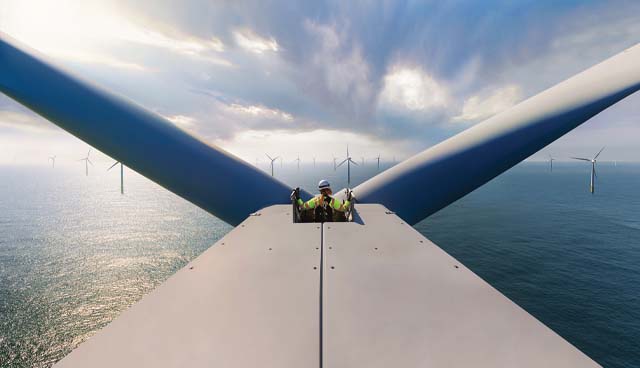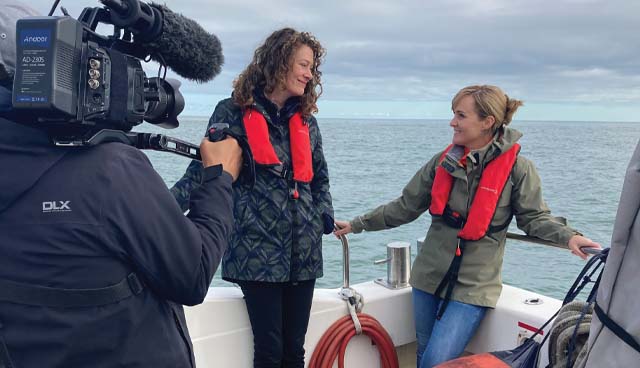SSE Renewables: Power to progress

Maria Ryan, Director of Development at SSE Renewables, addresses the key issues affecting the delivery of Ireland’s renewable energy ambitions.
What is the potential for offshore wind energy in Ireland?
Our territorial waters are 10 times the size of our land mass so the potential for offshore wind in Ireland is huge. It is an entirely new industry that will not only contribute to fighting the climate crisis but will create thousands of jobs, billions of Euro of economic investment and support communities with multi-million Euro annual Community Benefit Funds. In comparison to other renewable technologies it has the ability to deliver at scale. The question is whether action can be taken in time for us to reach the climate action targets set out in the Programme for Government seeking 5,000MW of offshore wind by 2030.
SSE Renewables is ready to deliver Ireland’s first offshore wind farm of scale, Arklow Bank Wind Park Phase 2, by 2025 which would kick-start the industry and power the country’s green recovery. This project alone will require an investment of between €1 billion and €2 billion, deliver circa. €860 million gross value-added to the island of Ireland and create circa. 10,500 FTE years nationally, circa. 4,800 of which will be local. Offshore wind presents a massive opportunity for Ireland but to ensure delivery on targets a robust marine planning system, a much stronger electricity grid and a firm date for the first offshore renewable electricity auction is required.
How can we overcome the key challenges facing the Irish offshore wind industry?
There are many challenges facing the offshore wind industry in Ireland and while the political will is there, the pace at which progress is being made is simply not quick enough. The thorough development of an offshore wind farm can take many years, with construction taking multiple years due to their scale, we are only nine years from the end of the decade and the frameworks to facilitate the development of new offshore wind projects are not yet in place, the next 12 months will be key.
We are hopeful that the MAP (Maritime Area Planning) Bill will be enacted by year end. However, it looks increasingly likely that planning guidelines won’t be published before the end of 2022 and therefore it will be mid-2023 before projects will be in a position to submit fully formed planning applications to An Bord Pleanála.
Even then, after a potential two-year consenting process, developers could be put back to the starting line if their application is refused. It is critical that this ‘one-shot at planning’ approach is amended so that developers have an opportunity to redesign the project and re-apply if appropriate, rather than being left with nothing to show for a multi-million Euro spend and years of work.
We estimate that MAP projects will not start to deliver until 2028 at the earliest and we are concerned that the 5GW by 2030 will not be achievable. The interim target of 1GW of offshore wind by 2025 in the 2019 Climate Action Plan appears to have been quietly abandoned and focus shifted to the 2030 targets, we cannot back-end delivery to the end of the decade, action is required now. SSE Renewables can deliver the 520MW Arklow Bank Wind Park Phase 2 under its existing Foreshore Lease by 2025 and contribute to this interim target.
What’s your understanding of delays in the Renewable Electricity Support Scheme (RESS) for offshore wind?
While we welcome the publication of the Terms and Conditions for the Offshore RESS auction in October 2021, the overall delivery timeline has already slipped from 2021 to the end of 2022 and is very likely to slip further. This is largely as a result of delays incurred by other dependent pieces of legislation and policy.
What impact will further delays to the Offshore RESS have on future ambitions?
It is of significant concern to SSE Renewables that RESS looks set to progress without planning approval as a pre-requisite. If RESS contracts are awarded to prospective projects that are not consented the reality is they may never deliver, those contracts are then redundant and Ireland is left further away from meeting climate targets by the end of the decade.

SSE Renewables’ proposed Braymore Point and Celtic Sea Array projects off the coasts of Louth and Waterford respectively will be amongst the first offshore wind projects to seek seabed and consent via the new MAP regime and new regulatory authority MARA (Marine Area Regulatory Authority). We would like to see MARA set up as soon as possible to facilitate the progression of the offshore pipeline in Ireland.
How will Ireland’s national grid accommodate the additional generation produced offshore?
In simple terms, we need a stronger grid, capable of taking the electricity generated by offshore wind farms and delivering it to customers. As it stands the Irish electricity grid is not strong enough to accommodate the 5,000MW offshore wind target set out in the Programme for Government. EirGrid’s grid development strategy is expected to be published by the end of this year, it is crucial that all relevant stakeholders engage with this process and once finalised, the strategy must be endorsed widely, by both political stakeholders and the public in order to ensure that the national grid can be developed so that it can cater for the growing offshore wind industry to support decarbonisation.
What role will onshore wind energy play in Ireland’s route to net zero?
SSE Renewables will continue to develop both onshore and offshore wind, both of which will significantly contribute to the decarbonisation of the electricity system. We have an extensive onshore and offshore development portfolio and by 2030, we plan to deliver an additional 700MW of onshore wind, doubling our current onshore operational portfolio, in addition to 2GW of offshore wind.
Much of the existing onshore fleet across the island is coming of age and will soon be in need of repowering or extension of life. It is essential that repowering and life extension projects are facilitated, so that the gains made through the development of onshore wind is retained. Flexibility is needed for repowering projects must be reflected in national policies including the long-awaited updated Wind Energy Guidelines.
www.sserenewables.com






